 |
Old Bull Lee A Voice From the Reality-based Community Notes from a Study of Things Themselves |
 |
The Michael Hastings Police Report - A Critical Examination
--Lyndon Johnson, after learning of JFK's efforts to use gangsters to assassinate Fidel Castro
When 33-year-old Michael Hastings, the investigative journalist and anti-war war correspondent, died in a fiery car crash on June 18, 2013, his admirers suspected murder. They suspected that dark, covert forces within the federal government--the FBI, CIA and JSOC, with tech support from the NSA--might have hacked the electronics in his Mercedes C-250 coupe, causing it to speed out of his control and run head-on into a tree in a residential street in Los Angeles.
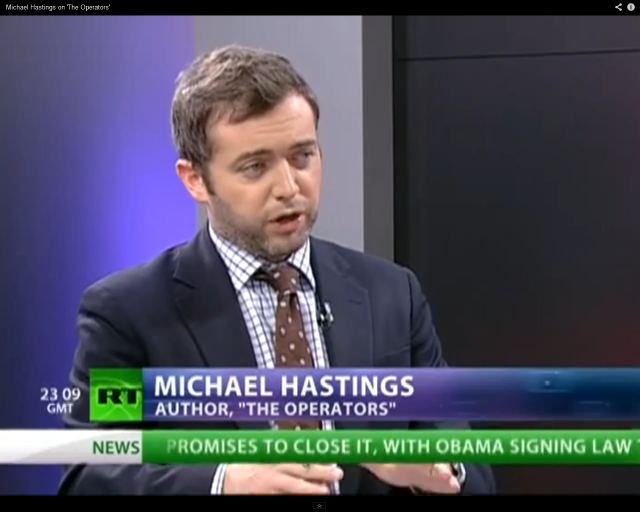
The LAPD was on the accident scene shortly after it occurred. A day or so later they claimed there was no foul play and promised a full report in two months. True to their word, that report was posted online August 20.
The report declares officially that Michael Hastings' death was accidental. It was not a natural death, not a suicide, not a homicide, and not a could-not-be-determined death. A consequence of the ruling is that there will be no further investigation by the LAPD.
The death-by-accident ruling was expected, but some were disappointed that homicide was not even considered. Hastings' car was traveling upwards of 80 mph when it crashed and exploded on a residential street, yet Hastings was known as a cautious driver. In addition, Hastings had repeatedly expressed his belief that (1) he was being investigated by the "Feds" and (2) that his 2013 model Mercedes C-250 coupe had been tampered with. Such tampering with electronics of a modern car could take throttle and brake control away from the driver and accelerate the vehicle to a high speed while the driver could only steer. Furthermore, the violent explosion-upon-impact suggested that an incendiary device ignited the fire that engulfed the car.
Related Posting: Michael Hastings' Last Ride
Who could pull off such a homicide? Well, the FBI, CIA and the NSA, to name three. Also, there's the Joint Special Operations Command, or JSOC. They're the government's professional assassins whose most famous victim was Osama bin Laden. These murderous outfits not only had the means and motivation to sabotage Hastings' car but also the privilege of operating in total secrecy without any public accountability or meaningful oversight. It's also important to note that the FBI polices the LAPD but nobody polices the FBI. We must assume the LAPD wrote their report knowing the FBI was looking over their shoulder. And the FBI did not want any suggestion of homicide.
Hastings' reporting had damaged the careers of powerful government officials who had connections to the covert organizations mentioned previously. Hastings was a go-to figure for leakers of nasty secrets held by government agencies. At the time of Hastings' death, the US Department of Justice was engaged in a frantic "war on journalists," a program of prosecuting leakers of government secrets and the journalists who publish those leaks. If the DOJ had a kill list of journalists, Hastings would be on it.
In his 2012 book The Operators, Hastings describes a conversation with Dave Silverman, General Stanley McChrystal's chief public relations officer. Hastings had just joined McChrystal's entourage as an embedded reporter.
Five pages earlier Hastings had described "C."Dave came up to me. "You're not going to fuck us, are you?"
I answered what I always answer: "I'm going to write a story; some of the stuff you'll like, some of the stuff you probably won't like."
Jake [McFerren, a McChrystal adviser] came up to me. "We'll hunt you down and kill you if we don't like what you write," he said. "C. will hunt you down and kill you."
C. was a member of the SAS, the most elite British commando unit, and if I used his real name, I could possibly put his life at risk....C., in his early thirties, was a veteran of Iraq and Afghanistan....
C., I'm told, is a crazy motherfucker. He liked to drive around Kabul in a Toyota Land Cruiser. He kept a nine-millimeter pistol in the driver's side door compartment, an MP5 submachine gun resting on the driver's side seat, a LAW rocket launcher in the backseat, and a machine gun mounted in the trunk.
A couple of months later Hastings published his article about McChrystal in Rolling Stone. Immediately afterward, the four-star general and commander of US forces in Afghanistan submitted his resignation to the president.
The police report contains input from a detective, doctors and toxicologists. The LAPD detective's input into Hastings' death is skimpy. There's a description of the accident scene and a short report consisting only of information gathered from an interview with one person: Michael Hastings' brother. There is an autopsy/medical report that concludes Hastings' died of "traumatic injuries" and not from burns or smoke. There is a toxicology report that indicates there was no alcohol, cocaine, DMT or barbiturates in his blood. They medical examiner did, however, say:
Toxicology shows a small amount of amphetamine in the blood, consistent with possible intake of methamphetamine many hours before death, unlikely to have an intoxicative effect at the time of the accident. Marijuana was present in the blood, but mostly in the form of its metabolite, indicating intake hours earlier.
There is a disconnect between the part of the report written by the detective/coroner and the parts written by toxicologists. The detective assigned to the case seemed obsessed with Hastings' drug use. From his investigation, including the interview with Hastings' brother, he states:
- "[Hastings'] family was attempting to get [Michael] into rehab"
- "[Hastings] was currently using DMT"
- "medical marijuana...ID card found in [Hastings'] wallet"
- "[Hastings] collided with a pole several years ago...believed to be [the result of] misusing Ritalin"
- "[Hastings] was institutionalized for rehabilitative care ~1999"
- "[Hastings' brother] would not be surprised if any stimulants were found in [Michael's] residence, including cocaine"
- "[Hastings] had 'passed out' about 0030 the morning of the crash"
As a result of the detective's obsession, much of the media coverage of the report was misleading. For example, an August 20 posting on the Los Angeles Times website is headlined, "Michael Hastings' Family Planned 'Detox' at Time of Crash." The casual reader might get the impression that Michael Hastings was wacked out on dope when his car exploded after colliding with a tree. He'd have to read down to the end of the third paragraph to learn that authorities "did not believe the drugs were a contributing factor in the crash."
An ABC news report was even worse. The first five paragraphs tell us about Hastings' drug use but the reader has go to the sixth paragraph to learn drugs were not the cause of his crash.
In addition to ignoring homicide as a possible cause of death, the police report also fails to consider suicide.
There are strong reasons to suspect suicide. To his credit, the investigating detective mentions that Hastings is not known to have previously attempted suicide. However, he also informs us that (1) Hastings had PTSD, (2) his family once thought he was bi-polar, and (3) Hastings thought he was invincible and could jump off a balcony without getting hurt. It's obvious Hastings was driving suicidally at the time of the crash and an eyewitness not questioned by the detective said so. Also, Hastings might find it extremely depressing that his brother not only thought he was crazy, but had come all the way from New York to LA to put him back into rehab. And the detective never questioned Hastings' associates and friends who knew Hastings to be depressed and agitated over being surveilled by the Feds.
It seems that the coroner and investigating detective, two days after the crash, had already decided on the cause of death: an accident resulting from drug intoxication. But the toxicology report, which was completed two months later, didn't support them. The toxicology report said Hastings didn't have enough drugs in his body to affect his driving. So, since Hastings wasn't high on drugs, what caused the reckless driving? A suicidal death wish? Or was his car sabotaged?
Page-by-page Examination of the Report
A PDF version of the LAPD report is online here. (If that link doesn't work, try this one.)
(For details of the car crash, based entirely on non-LAPD, non-FBI sources, see here.)
The police report is made up of several sub-reports.
Accident Report (page 1). This is a standard form stating details of the accident such as time and place. There is a box for "Special Circumstances" at the top. It's filled in with: "Media Interest." A box at the bottom of the page asks for "Synopsis." The last two and a half lines of the six-line synopsis are these three sentences.
SOCIAL HX [history?] INCLUDED POLYSUBSTANCE USE W/REPORT DECEDENT HAD BEEN SMOKING MARIJUANA THE NIGHT PRIOR. HE WAS ALSO BELIEVED AS USING DMT (HALLUCINOGENIC). FAMILY HAD JUST ARRIVED FROM NY THE DAY PRIOR, ATTEMPTING TO GET THE DECEDENT TO GO TO REHAB...
The Accident Report is signed by Selena Barros and dated 6/19/2013 at 16:59.
Department of Coroner Investigator's Narrative (pages 2-4). About a third of this narrative is devoted to Informant/Witness Statements, which is where the problems are. We discuss this in detail later.
Autopsy Report (pages 5-11). The list of injuries goes on for a page and a half: fractures, contusions, lacerations, avulsions, charring, etc. Final conclusion is shown below.
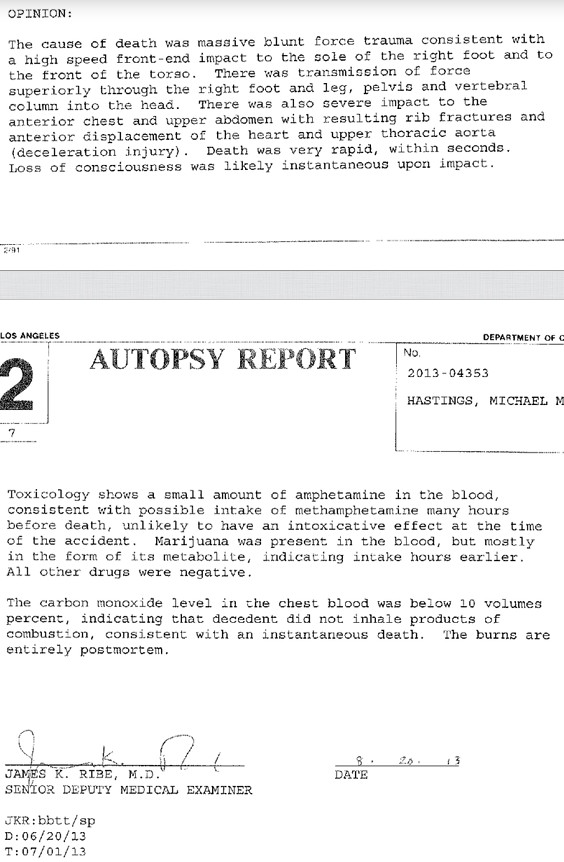
Medical Report (page 12). This sheet declares death was caused by "traumatic injuries" and was an accident, as opposed to a homicide, suicide, natural death or could-not-be-determined.
Autopsy Check Sheet (page 13). Worksheet showing autopsy notes.
Anatomy Diagram (page 14). Line drawing of front and back of human form with physician's notations as to locations of fractures and charring.
Laboratory Analysis Summary Report (page 15). No ethanol (alcohol), cocaine, barbiturates or opiates. Some marijuana and amphetamines.
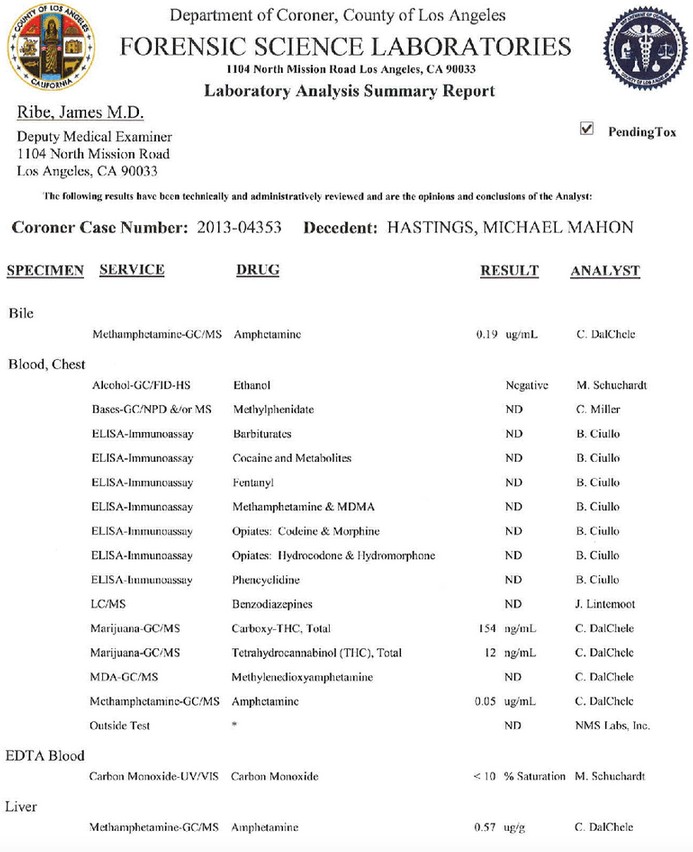
The laboratory report is dated August 16, 2013.
Questions for further research: (1) at what levels of THC would a person's driving be impaired? (2) same question as #1, but for amphetamines? (3) what would be the nature of driving impairment for a person with high levels of amphetamines? (4) could the amphetamines have come from prescription drugs such as Ritalin or Adderall? (5) how common is it for people stoned on marijuana to drive cars at high speed into fixed objects? I thought people stoned on marijuana would be disinclined to drive at all, and if they did, they'd drive so slow as to cause traffic jams.
Explanation of terms (page 16). ND = "Not Detected", ug = micrograms, etc.
NMS Labs Report (page 17). The LA coroner sent Hastings' blood to NMS Labs in Pennsylvania for analysis. They tested for dimethyltryptamine (DMT) and detected none. Their report is dated 8/10/2013 at 17:00.
Background to the Coroner/Detective Interview
Before analyzing the coroner's statement on the next-of-kin notification and interview, we need to put Michael Hastings' untimely death into the context of his professional career and the national events unfolding at that time.
Hastings started working at Newsweek just out of college in 2002 and began covering the Iraq and Afghanistan wars in 2005. He complained that Newsweek and other mainstream media outlets edited out much of the material he submitted, material he thought was important and incisive. So he turned to Rolling Stone, which would publish his stories as he wanted them to appear in print.
In 2010 he got an embedded position covering General Stanley McCrystal, commander of Nato forces in Afghanistan. After a few months with the McCrystal entourage in Europe and Afghanistan, he published an article that would make his name as a journalist: "The Runaway General." Wikipedia says: "The article reported remarks by McChrystal's staff that were overtly critical and contemptuous of White House staff and other civilian officials." McCrystal resigned and Hastings was disembedded for life. In another Rolling Stone article Hastings profiled McCrystal's successor David Petraeus as a master of manipulating Washington bureaucrats by spinning his Afghanistan strategy of bribery and death squads as modern counterinsurgency.
On June 6, 2013, twelve days before Hastings' death, journalist Glenn Greenwald of the UK Guardian published the first of a series of articles about the National Security Agency's surveillace programs and the Agency's covert relationships with major US corporations such as Google, Facebook and Microsoft. Greenwald's source was Edward Snowden, a former NSA employee. The Snowden leaks exposed massive US spying on American citizens and on American allies such as the European Union, France, Germany and Brazil. They exposed the notorious FISA court, which operates without transparency or accountability, issuing secret rulings based on secret laws. It exposed the Director of National Intelligence, James Clapper, as a liar to the US Senate. After Hasting death we learned that the US government's secret budget for covert activities was 52 billion dollars a year. NSA's portion was $10.8 billion.
The Snowden leaks threw the NSA into a panic. The FBI mobilized its resources towards stanching the leaks, threatening punitive action against anyone who would aid or abet leakers. Author Jeremy Scahill, who has written extensively about US secret policies of torture and drone strikes, called the government's response a "war on journalism."
On June 7 Hastings used his BuzzFeed blog to castigate Democrats for their weakness and hypocrisy regarding civil liberties. He referenced Greenwald and said:Transparency supporters, whistleblowers, and investigative reporters, especially those writers who have aggressively pursued the connections between the corporate defense industry and federal and local authorities involved in domestic surveillance, have been viciously attacked by the Obama administration and its allies in the FBI and DOJ.
Little is known publicly about Hastings' whereabouts and activities in the days preceding the fatal crash. Of particular interest: who he associated with and communicated with, where he was, what were his habits, where he lived. There was a rumor that he was working on a story about Jill Kelley, a Tampa socialite connected to David Petraeus, former general and CIA director. There was another rumor he was working on a story about John Brennan, director of the CIA. A third rumor was that he was in contact with Barrett Brown, a computer hacker who had exposed e-mails from Stratfor, a privately-owned intelligence company.
Hastings' wife said he was always working about five stories at a time.
Until the publication of the police report in August, the public knew of only two things Hastings did in the twenty-hour period before his death.
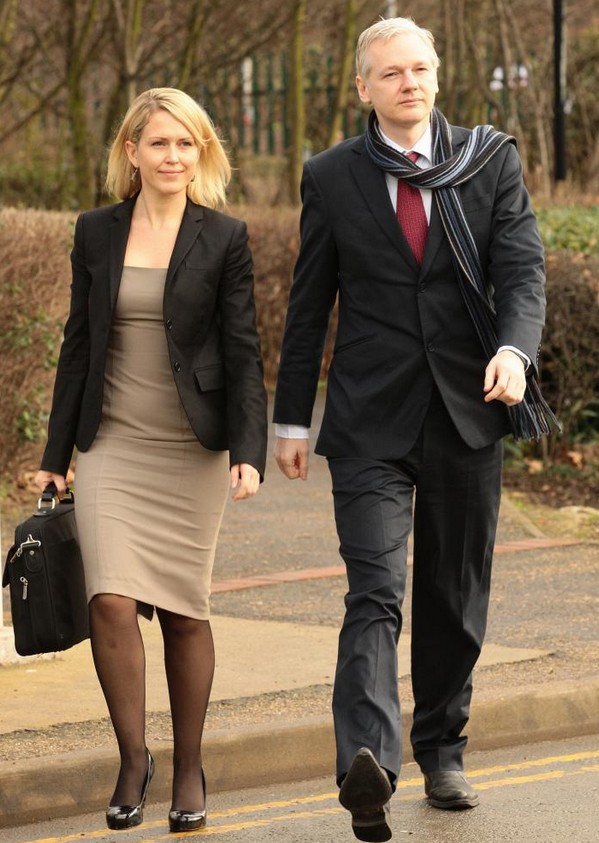
One thing was to contact a British lawyer with experience representing Julian Assange, an advocate of government transparency and founder of the WikiLeaks website. Wikileaks published classified records from the Iraq and Afghanistan wars, US diplomatic cables and data about Guantanamo prisoners, bringing enormous embarrassment to US government officials.
Assange tweeted as follows: "Michael Hastings contacted WikiLeaks lawyer Jennifer Robinson just a few hours before he died, saying that the FBI was investigating him."
Jennifer Robinson represented Assange in his battle to avoid extradition from the UK to Sweden, where he is wanted for trumped-up sex accusations.
The second thing we know is that Hastings sent the e-mail shown below.
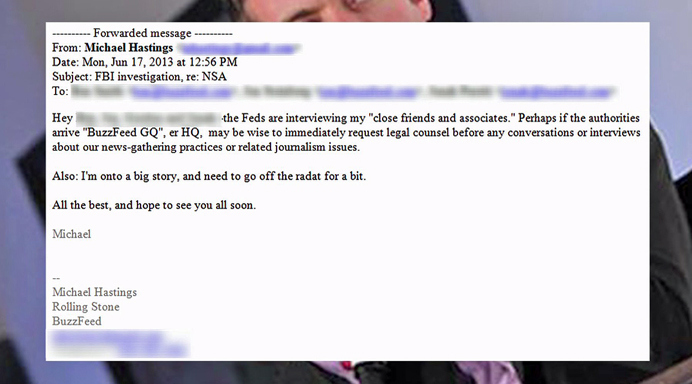
The e-mail was made public by Sergeant Joe Biggs, who got a blind copy. Biggs was a friend of Hastings and is mentioned in Hastings' 2012 book, The Operators. In commenting on this e-mail to the media, Biggs volunteered that Hastings "drove like a grandma."
It's worth noting that:
- The time stamp is June 17, 2013 at 12:56 pm, about 15 hours before Hastings' death.
- The subject line reads: "FBI Investigation, re: NSA". We know that Hastings' thinks the FBI is investigating him. We also know the FBI was frantically trying to minimize the damage caused by the recent leak of NSA files by Edward Snowden. Does the FBI think Hastings had some connection with the Snowden leak?
- Hastings warns his recipients to request legal counsel before talking to the authorities, presumably the FBI. He knows the FBI tries to trap suspects in a lie and that lying to the FBI is a crime. (It's not illegal for the FBI to lie, though. They do it all the time, to both suspects and to the public. Martha Stewart did five months in prison for lying to the FBI.) The FBI subsequently claimed they weren't investigating Hastings. Yeah. Right.
- He says he's going to "go off the radar." What does that mean? Maybe to meet with someone whose identity he doesn't wish to reveal? To go into drug rehab?
- He closes with, "...hope to see you all soon." Doesn't sound like someone planning to commit suicide.
Shortly after release of the police report, a third individual came forward to reveal first-hand information about Hastings' last days and hours. She is Jordanna Thigpen, Hastings' apartment-building neighbor. She is among the sources of a long August 22 article posted at the LA Weekly website. From the article, entitled "Michael Hastings' Dangerous Mind: Journalistic Star Was Loved, Feared and Haunted," we learn
- "In February [2013], Hastings had rented a one-bedroom apartment with a gorgeous view overlooking Hollywood. The landlord allowed him to use another unit, the one below Thigpen's, to write."
- After Snowden's revelations about the NSA, Hastings [according to Thigpen] "came to believe his Mercedes was being tampered with."
- "One night in June, [Hastings] came to Thigpen's apartment after midnight and urgently asked to borrow her Volvo. He said he was afraid to drive his own car. She declined, telling him her car was having mechanical problems. 'He was scared, and he wanted to leave town,' she says. The next day, around 11:15 a.m., she got a call from her landlord, who told her Hastings had died early that morning."
- "When he got to L.A., she [Thigpen] says, he got a prescription for medical marijuana and smoked regularly."
- "In May, Hastings traveled to Washington and New York and visited his editors. As usual, he was full of ideas - maybe something on the underbelly of Hollywood. He also was interested in doing something on surveillance, maybe a book."
- "The NSA stuff ... really rocked him a bit," says [David] Rosenthal, his editor. "I'm not a doctor, but he certainly was agitated in the last day or two of his life."
- "Jordanna Thigpen says that at 12:30 a.m. [June 18], Hastings came to her apartment and asked to borrow her car. He was scared, she says, and trying to get out of town."
- "That afternoon, about two hours after Hastings announced he was going off the radar, he and his brother stopped into Peas & Carrots International, a clothing shop in West Hollywood. He stayed in the store about 15 minutes, buying two T-shirts, and seemed in high spirits, co-owner Joshton Peas says. 'He was really chatty,' Peas says. 'He seemed like a normal guy - he was a little more amped up, passionate.'"
The Detective Narrative
Now let's take a close look at pages 2 - 4 of the police report. (Click on the images below to see full size.)
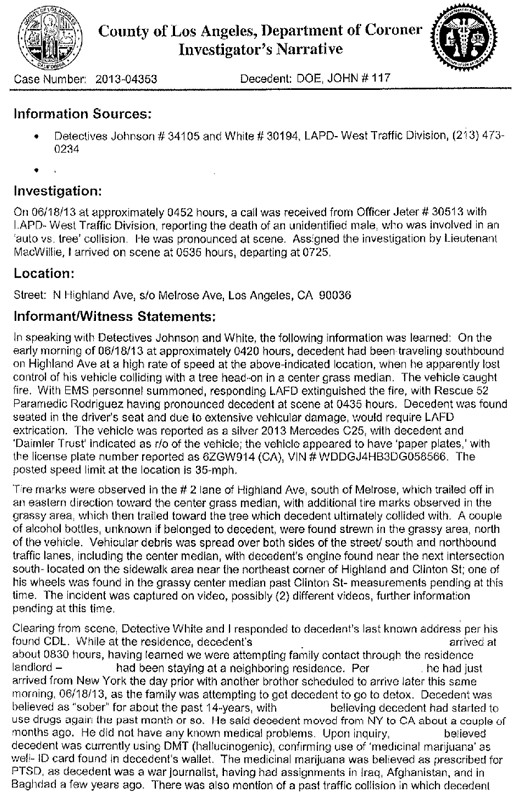
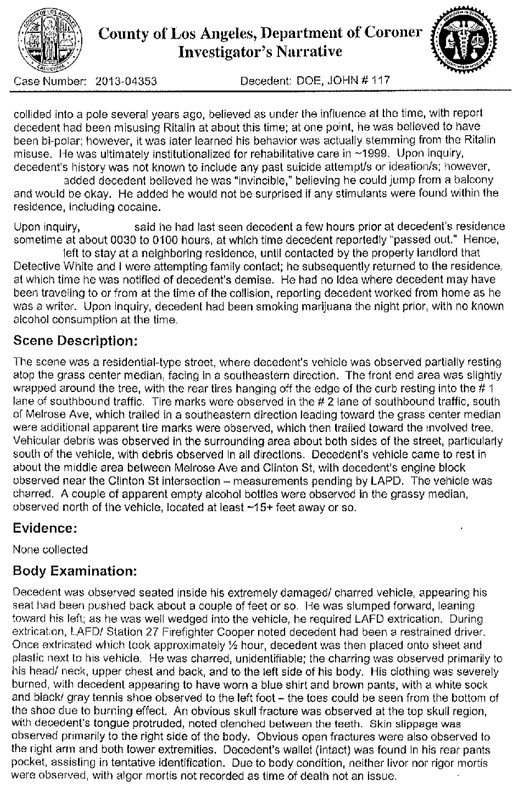
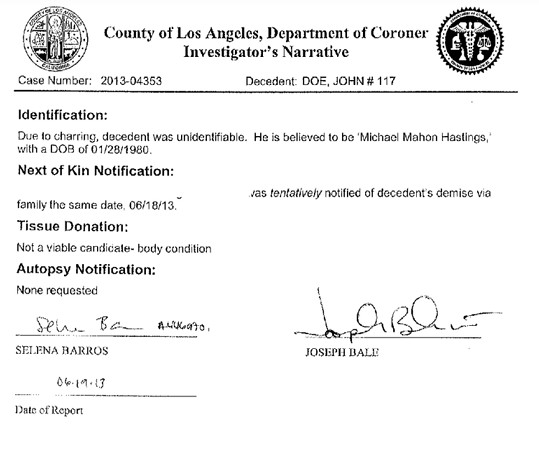
The Department of Coroner Investigator Narrative is signed by Selena Barros and Joseph Bale. It's not clear what their individual roles were. It's dated 6/19/2013, the day after the crash.
The first two paragraphs under the heading "Informant/Witness Statement" give the detectives' description of the crash scene. That description does not conflict with what has already been covered on this website. One interesting item heretofore unknown is that Michael Hastings' car was leased, not owned. The lessor was Daimler Trust, a financial subsidiary of the Mercedes Benz company.
In the third paragraph the coroner (presumably Selena Barros) and Detective White seek out Hastings' next-of-kin by going to the address on his CDL (California Drivers License). The second and third sentences deserve attention.
While at the residence, decedent's [redaction #1] arrived at about 0830 having learned we were attempting family contact through the residence landlord - [redaction #2] had been staying at a neighboring residence. Per [redaction #3] he had just arrived from New York the day prior, with another brother scheduled to arrive this same morning 6/18/2013, as the family was attempting to get decedent to go to detox.
Redaction #1 appears to be Michael Hastings' brother. Redaction #3 appears to be the same brother. Michael Hastings had a younger brother Jeff and an older brother Jon. In Hastings' book I Lost My Love in Baghdad, he says Jeff went to Ranger school and was an infantry platoon leader in Iraq. Since it's not clear which brother's name is redacted, I'll refer to him as "brother #1".
Decedent was believed as "sober" for about the past 14 years, with [brother #1] believing decedent has started using drugs again the past month or so. He said decedent had moved form NY to CA about a couple of months ago. He did not have any known medical problems. Upon inquiry, [brother #1] believed decedent was currently using DMT (hallucinogenic) confirming use of medicinal marijuana as well- ID card found in decedent's wallet. The medicinal marijuana was believed as prescribed for PTSD as decedent was a war journalist, having had assignments in Iraq, Afghanistan and in Baghdad a few years ago.
According to the LA Weekly article, Hasting moved to LA in February. That would be four months ago, not "a couple of months ago" as brother #1 says.
The report suggests brother #1 volunteered that he was in town to put Michael Hastings into detox because he'd started using drugs again. This leads us to ask, (1) why did he volunteer this information at all, and (2) why had he and brother #2 come to believe Hastings had relapsed into drug use and was taking DMT?
There has been no indication from Hastings' LA associates, including Jordanna Thigpen, that he had relapsed into problematic drug use. Is it unreasonable to consider that covert government operatives had initiated a whispering campaign intending to drive Michael Hastings to suicide? You must remember that this is exactly what the FBI did to Bruce Ivins, the accused anthrax mailer. In the anthrax case the FBI harassed the Ivins family for months, repeatedly disparaging Ivins to his wife and children. Although the family remained convinced of Ivins' innocence, he committed suicide. The suicide relieved the FBI of their obligation make their case in court, where their prosecution would likely have failed.
There was also mention of a past traffic collision in which the decedent collided with a pole, believed as under the influence at the time, with report decedent had been misusing Ritalin at about this time; at one point, he was believed to have been bi-polar; however, it was later learned his behavior was actually stemming from the Ritalin misuse. He was ultimately institutionalized for rehabilitave care in ~1999. Upon inquiry, decedent's history was not known to include any past suicide attempts or ideations; however, [brother #1] added decedent believed he was "invincible," believing he could jump from a balcony and would be okay. He added he would not be surprised if any stimulants were found within the residence, including cocaine.
According to Michael Hastings' writings, the drug abuse, the collision with the pole and the rehabilatative care all took place when he was 19 years old, or about 1999. He claimed that after all that, he decided to stay sober.
Upon inquiry, [brother #1] said he had last seen decedent a few hours prior at decedent's residence sometime at about 0030 to 0100 hours, at which time decedent reportedly "passed out." Hence, [brother #1] left to stay at a neighboring residence, until contacted by the property landlord that Detective White and I were attempting family contact; he subsequently returned to the residence at which time he was notified of decedent's demise. He had no idea where decedent may have been traveling to or from at the time of the collision, reporting decedent worked from home as he was a writer. Upon inquiry, decedent had been smoking marijuana the night prior, with no known alcohol consumption at the time.
Some questions. (1) Why does brother #1 use the term "passed out"? It would be just as easy to say he "fell asleep." After all, it was late at night. (2) Jordanna Thigpen claims Michael Hastings came to her apartment at 0030 seeking to borrow her car. This is when Hastings had supposedly passed out. What's the reality?
Update November 7, 2013: Jonathan Hastings Interview
The transcript of a long interview with Jonathan Hastings, Michael's older brother, was posted online November 5. The interviewer was Ray Sawhill of the Salon website. An abbreviated version can be read here and the full version can be read here.
The interview clears up some open questions, one being, who is the brother interviewed by the police detective shortly after the crash? The answer: Jonathan Hastings, AKA "brother #1" in this posting.
The second question the interview clears up is this: why doesn't the LAPD report mention that Michael Hastings believed his car had been tampered with? The interview strongly suggests that Jonathan Hastings didn't tell the detective and the detective didn't interview anyone else. And the reason Jonathan didn't tell the detective is that Jonathan had dismissed the possibility of tampering, so convinced was he that Michael was crazy and undergoing a "manic episode."
Here's the important stuff from the interview.
PR [Paleo Retiree, apparently as pseudonym for Ray Sawhill]: I know you flew out to check in on Mike just a day or two before the crash.
JH: As I told the police out in L.A., a few days before he died, Mike called me and I got the impression that he was having a manic episode, similar to one he had had 15 years ago which he had referred to in his writing. At that time, drugs had been involved, and I suspected that might be the case again. I immediately booked a flight to L.A. for the next day, with the thought that maybe I could convince him to come back to Vermont to dry out or (less likely) get him to go to detox/rehab there in L.A. When I got to L.A. and saw him, I immediately realized that he was not going to go willingly. I started to make arrangements with our other brother to fly out and help me possibly force Mike into checking himself into a hospital or detox center. I'd thought that I had at least convinced Mike to just stay in his apartment and chill out for the next few days, but he snuck out on me when I was sleeping. He crashed his car before anyone could do anything to help him.
PR: Lordy.
JH: I ended up telling this all to the police on Tuesday morning, as I was one of the last people to see him alive and I was one of the few people who could really put his behavior on that day in context.
PR: How good a job do you feel the cops have done looking into the crash?
JH: I feel that the investigation was pretty thorough. The LAPD was very easy to work with, and I think they did a good job. I certainly have no real complaints about them or the coroner's office, and I think everyone in my family is satisfied with the report. For the most part, it didn't tell us anything we didn't already know or strongly suspect.
PR: Any disagreements with it?
JH: Not really. I think there's a larger context that it leaves out, but a lot of that stuff seems to me to be out of the scope of a report about a traffic accident
A little later:
PR: What are your own thoughts about the cause of death? Do you have any feelings at all that foul play might have been involved?
JH: I really rule out foul play entirely. I might have been suspicious if I hadn't been with him the day before he died. After all, he definitely was investigating and writing about a lot of sensitive subjects. But based on being with him and talking to people who were worried about him in the weeks leading up to his death, and being around him when he had had similar problems when he was younger, I was pretty much convinced that he wasn't in danger from any outside agency.
PR: It did seem weird, the way that the Mercedes more or less exploded, and that the engine was thrown so far away.
JH: I think the explosion and everything else can be accounted for by the fact that his car was going really, really fast. That's a lot of kinetic energy and a lot of fuel involved when you're going full throttle like that.
Observations and questions about the Jonathan Hastings interview:
- Jonathan doesn't repudiate his own remarks as represented in the LAPD detective report.
- He doesn't acknowledge that Michael was not intoxicated when he crashed his car. Did Jonathan actually read the LAPD report?
- He states he doesn't believe there was foul play. But he seems unaware or unwilling to disclose that Michael believed his car had been tampered with. Jonathan does not seem to understand that because Michael is paranoid doesn't mean they're not out to get him.
- After he got to LA, he "immediately" realized Michael didn't like the rehab idea. Why should Jonathan be surprised? Did it occur to Jonathan that Michael might be offended or depressed because his brother thought him to be crazy, drug-addled and out-of-control?
It's important to note that Jonathan gives us no concrete reason to disbelieve Michael's car was hacked. And Jonathan seems oblivious to the possibility that his effort to get Michael into rehab might have driven Michael to suicidal behavior.
The interview absolves the investigating detective of "obsessing" about Michael Hastings' alleged drug use. The person actually obsessed with Michael's supposed drug use was Jonathan, the only person questioned by the detective. The toxicology reports showed Michael had no DMT, cocaine, barbiturates or alcohol in his system at the time of death and the small amount of marijuana and amphetamines in his body would not have affected his driving.
It's understandable that Jonathan, at a time of shock and grief about his brother's untimely death, might blab and run on about his theories explaining Michael's behavior. However, two months after the publication of the toxicology report, he should acknowledge he was wrong.
Jonathan's refusal to acknowledge his error does a grave disservice to his late brother, whose life work, including his extraordinary book The Operators, will now be dismissed by the neocon war machine and most of the corporate media as the product of a drug-crazed nut case.
Still Unanswered Questions about Michael Hastings' Death
1. What's the "big story" Michael Hastings mentions in the e-mail he sent hours before his death?
2. In the time between 0030 and 0415 on June 18, 2013: (1) where was he? (2) what was he doing? and (3) who, if anybody, was he with or communicating with?
3. At the time of his crash, where had he come from and where was he going?
4. What reasons did he have to believe (1) he was being investigated by the Feds and (2) that his car had been tampered with?
5. Where does Hastings' wife, the lovely Elise Jordan, fit into this picture? She's not mentioned in the coroner's report or in any article or interview that goes into detail about Hastings' fatal crash. Did she play some role in getting the two brothers to visit Hastings in LA?
Some Conclusions and Opinions as of November, 2013
There's not going to be any further government investigation into Michael Hastings' crash. And a private investigation into the murder-by-car-hacking conjecture would get nowhere because the forensic evidence chain-of-custody has been lost.
In considering the car hacking hypothesis, we must accept that the US government can and does murder people. But mostly they murder foreigners, whose lives they can claim aren't protected by the US constitution. As a practical matter, though, the FBI, and possibly other covert government organizations, can murder Americans without fear of prosecution. That's because nobody polices the FBI.
A recent example of an FBI murder that will go unpunished is the killing of Ibragim Todashev, a friend of Boston Marathon bombing suspect Tamerlan Tsarnaev. Another example is the beating death of Kenneth Trentadue, who the FBI thought might have a connection (but didn't) to the 1995 Oklahoma City bombing.
The NSA, a service organization for the FBI (as well as for the CIA and JSOC), specializes in hacking Internet servers, encryption hardware and enemy weapon systems. Their most famous and destructive hack job was the Stuxnet virus. Stuxnet attacked a nuclear facility in Iran, destroying uranium enrichment centrifuges by causing them to spin out of control. Hacking the electronics of a Mercedes C-250 coupe would be far easier than creating the Stuxnet malware.
So, the fact that the FBI/NSA could have murdered Michael Hastings doesn't mean they did. My sense is that they did not. That sense comes from a lifetime of observing bureaucracies.
A plot to murder Hastings would require scarce resources: people-time and money. Many levels of bureaucratic approval would be needed. Budgets would have to be approved. Viewgraph presentations would have to be prepared. Personnel with high security clearances would have to be transferred in or hired. Secure office and laboratory space would have to be allocated. Expensive automobiles to be used for test and development would have to be purchased, along with specialized workstations to facilitate the creation of automotive malware. Also, there would be the delicate problem of acquiring the source code for the software and firmware already installed in automobiles.
It's hard to believe the government would go to all that trouble just to avenge Hastings' take-down article about General McChrystal's insubordination or his unflattering portrait of General David Petraeus. No, it would take a threat to a major on-going covert activity or program for the FBI/NSA to bring out the heavy artillery of automotive sabotage; that is to say, an affront of the magnitude of Julian Assange's or Edward Snowden's. So far, there's no indication that Michael Hastings was onto anything as big as the Collateral Murder video or the leak of the NSA's PRISM viewgraphs.
While the sabotage hypothesis seems less likely to be true than widely believed, I think the suicide hypothesis is more likely to explain his reckless driving. I don't think it's a coincidence that Michael Hastings crashed his car into a palm tree only a few hours after his arrogant older brother refused to take him seriously and tried to "force" him into a drug rehab program. Michael, an emotional and high-strung guy, had been living his last four months in an unfamiliar city, apparently without much emotional support from his wife or blood relatives. For someone who'd spent most of his working life as a war correspondent, LA must have seemed a let-down. No one he knew there could understand what it was like in a war zone like Iraq or Afghanistan, where he was no longer welcome. Possibly as a result of all this, his writing career wasn't going anywhere and he was likely depressed.